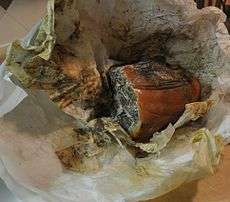Smithfield ham

Smithfield ham is a specific form of country ham finish-cured in the town of Smithfield in Isle of Wight County in the Hampton Roads region of Virginia, US.
History
The first record of the commercial sale of cured "Smithfield Ham" is a receipt to Ellerston and John Perot on the Dutch Caribbean Island of St Eustatius, dating from 1779.[1]
The state of Virginia first regulated usage of the term "Smithfield Ham" in a 1926 Statute passed by its General Assembly stating:
Genuine Smithfield hams [are those] cut from the carcasses of peanut-fed hogs, raised in the peanut-belt of the Commonwealth of Virginia or the State of North Carolina, and which are cured, treated, smoked, and processed in the town of Smithfield, in the Commonwealth of Virginia.
The "peanut fed" and "peanut belt" stipulations were removed in 1966. The present statute reads:[2]
...Genuine Smithfield hams are hereby defined to be hams processed, treated, smoked, aged, cured by the long-cure, dry salt method of cure; and, aged for a minimum period of six months; such six-month period to commence when the green pork cut is first introduced to dry salt, all such salting, processing, treating, smoking, curing, and aging to be done within the corporate limits of the town of Smithfield, Virginia
While it is unclear whether the green pork (the raw product of the cured ham) may come from hogs raised and slaughtered in other than Smithfield, Virginia; the statute's stipulation that the six-month (minimum duration) curing clock is to begin when the green pork is "introduced to dry salt"; and, that through the entire duration of the process, the ham and its processing must occur within Smithfield, Virginia. The statute also commands, that any richer, or more intense cure, obtained from an aging, that is in excess of six months, must also be done within Smithfield, Virginia.
Legally specifying the locality of a ham's whole curing process (including aging) ensures a uniformity in flavor, since the curing environment's air quality, humidity, temperature variation (both seasonal and daily); and, inoculation during curing/aging by local varieties of airborne mold spores (whose enzymes are produced as a byproduct of growth on the ham's rind) produce both a unique and systematically replicable flavor.
Gallery
-
.jpg)
Peanut-fed hogs
-
.jpg)
Hams in the dry salt process
-
.jpg)
Hams hung to age